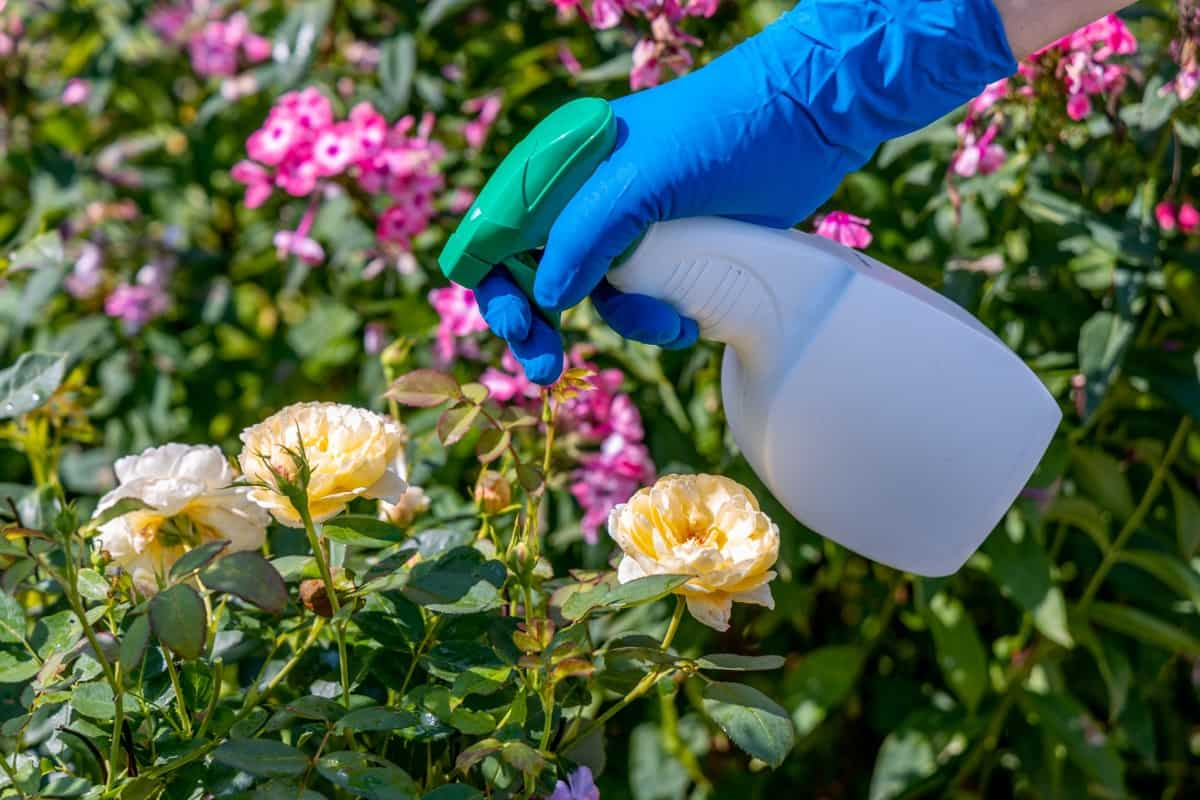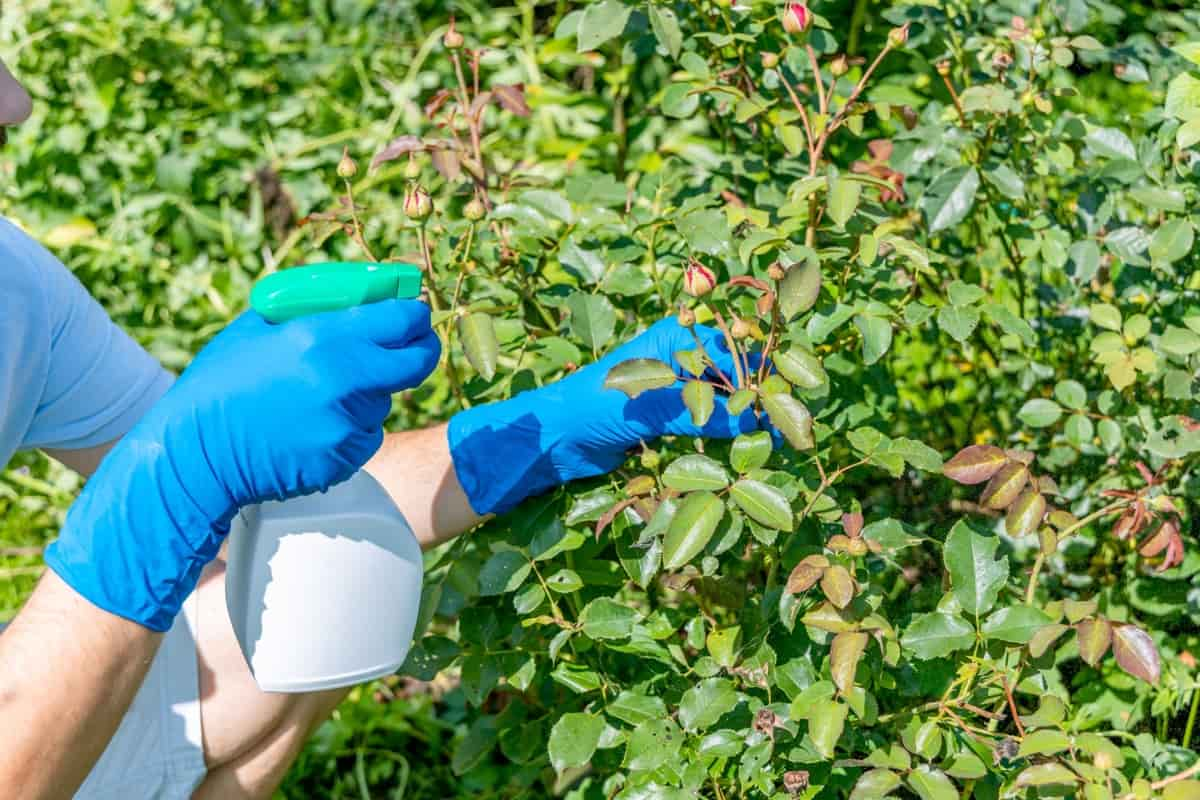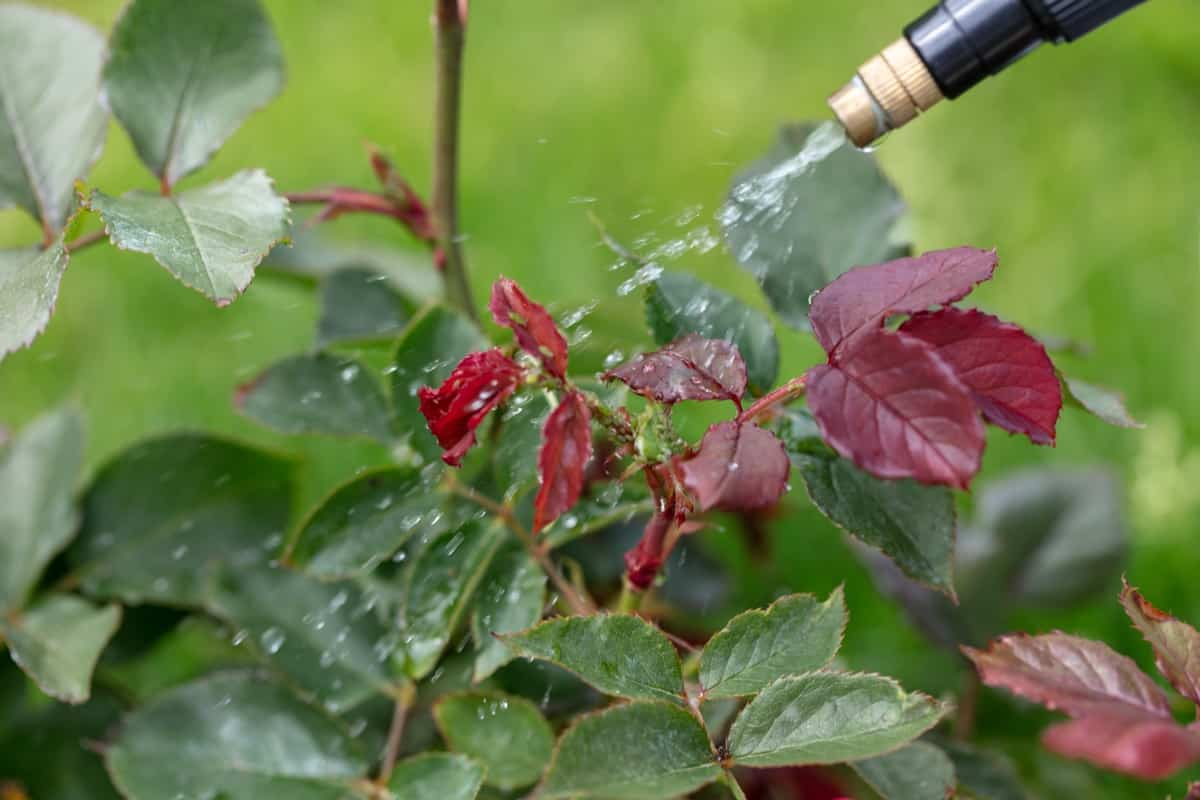Powdery mildew is a widespread fungal disease affecting numerous plants, including roses. It is caused by various fungi, with Podosphaera pannosa var. rosae being the culprit behind rose powdery mildew. This pathogen thrives in environments with high humidity, cool nights, and warm days, but unlike other fungi, it can grow on dry surfaces. This disease can quickly complete its life cycle in just a few days under optimal conditions.

Powdery Mildew Management in Rose
The Disease cycle of Powdery Mildew
The powdery mildew disease cycle starts with the fungus overwintering as dormant mycelium in the bud scales and rudimentary leaves of rose bushes. Infected buds break and open in the spring and develop into infected shoots, on which the fungus sporulates, producing large microscopic spores called conidia. These conidia are carried by wind or other means to healthy rose tissue, infecting the upper and lower leaf surfaces and initiating a new disease cycle.
Factors Favoring Population Increase in Powdery Mildew
- Moderate temperatures: Powdery mildew thrives in moderate temperatures between 68°F and 86°F, allowing optimal growth and reproduction.
- High relative humidity: Humid conditions above 95% create a favorable environment for the powdery mildew fungus to grow and reproduce.
Symptoms of Powdery Mildew
- Dwarfed and distorted new shoots in the spring.
- Whitish-gray mildew growth on new shoots and expanding leaves.
- Light green to reddish, slightly raised blister-like areas on the upper leaf surface.
- Dense, powdery white growth (mycelium, conidiophores, and spores) of the mildew fungus on infected leaves.
- Severely infected young leaves become curled or irregularly twisted and covered with enlarged, whitish-gray, powdery, mealy, or felt-like patches of the fungus.
- Infected leaves often turn reddish-purple, then yellow, dry, and drop prematurely.
- Older infected leaves develop round-to-irregular areas covered with flour-like mildew growth.
- Buds, young stems (canes), thorns, peduncles, fruit sepals, and even flower petals may become infected and entirely covered with the typically dense, flour-like growth.
- Flower petals may be discolored, dwarfed, and fail to open properly, causing the flowers to die early.
- Severe stunting of plants if they are heavily infected early in the growing season.
- Resistant rose cultivars may show a hypersensitive reaction where invaded dead cells appear as black-to-rusty specks on the leaf surface, with little evidence of mildew growth.
Powdery Mildew Management in Rose by Cultural method
- Remove and dispose of infected plant parts: Prune out and dispose of any infected leaves, stems, or flowers as soon as you notice them. This can help reduce the spread of the disease.
- Improve air circulation: As you mentioned, good air circulation can help reduce humidity and limit the spread of powdery mildew. This can be achieved by properly spacing plants, pruning to open the canopy, and removing any weeds or debris obstructing airflow.
- Water early in the day: Watering early in the day allows leaves to dry off quickly, which can help reduce humidity and limit the spread of the disease.
In case you missed it: Powdery Mildew Disease Management in Wheat: Symptoms, Treatment, Chemical, Biological, Natural, and Organic Control

Powdery Mildew Management in Rose by Biological Method
- Fungal antagonists: Some fungi can parasitize and kill powdery mildew. Examples include Ampelomyces quisqualis and Lecanicillium lecanii. These fungi can be applied to the plant as a fungicide.
- Bacteria: Bacillus subtilis and Streptomyces lydicus have been shown to reduce powdery mildew infection. They work by producing antifungal compounds that inhibit the growth of the pathogen.
- Predatory mites: Some mites feed on powdery mildew, such as Phytoseiulus persimilis and Neoseiulus californicus. These mites can be released onto the plants to control the pathogen.
- Parasitic wasps: Some parasitic wasps, such as Aphidius colemani and Aphidius ervi, can also attack powdery mildew. They lay their eggs inside the aphids that feed on the plant, and the wasp larvae consume the aphids and the powdery mildew they have ingested.
- Plant extracts: Some plant extracts, such as those from chrysanthemums, have been shown to have antifungal properties against powdery mildew. These extracts can be applied to the plant as a spray.
Powdery Mildew Management in Rose by Chemical Method
Chemical control of powdery mildew on roses typically involves the use of fungicides. Several fungicides can be effective against powdery mildew, including protectants and systemic fungicides. Some of the fungicides that are commonly used for powdery mildew control on roses are:
- Protectant fungicides are a barrier on the plant’s surface, preventing the fungus from establishing itself. Examples of protectant fungicides for powdery mildew include mancozeb, mancozeb/sulfur, and mancozeb/captain. These fungicides are typically applied every two weeks during the growing season.
- Systemic, curative, or eradicant fungicides are absorbed by the plant and can kill existing fungal infections. Examples of systemic fungicides for powdery mildew control on roses include bioethanol (a triazole fungicide), difenoconazole (another triazole fungicide), and trifloxystrobin/tebuconazole (a combination of a strobilurin and triazole fungicide). These fungicides are typically applied less frequently than protectant fungicides.
Preventive Measures for Control of Powdery Mildew
- Keep your garden clean and free from debris, which can provide a place for powdery mildew to overwinter.
- Apply a layer of organic mulch around plants to help retain soil moisture and keep the soil temperature consistent, which can help plants resist stress and disease.
- Use good garden hygiene, including cleaning up and removing diseased plant debris and sterilizing pruning tools between uses to prevent the spread of spores.
- Use a balanced fertilizer that is not too high in nitrogen, as this can encourage succulent growth susceptible to powdery mildew.
In case you missed it: Vibriosis Management in Vannamei: Disease Symptoms, Causes, Control, Prevention, and Treatment

Conclusion
Powdery mildew is a common disease that can severely affect the growth and blooming of roses. But with proper care and management, you can prevent and control powdery mildew. Gardeners can maintain healthy and beautiful roses by following chemical and preventive measures.
- Beneficial Insects in Pest Management
- Natural Solutions for Pest Control in Flower Gardens
- Types of Fungicides Used in Agriculture
- Common Issues in the Fruit Development Stage of Pomegranate Farming
- Fruit Development Issues in Papaya: Easy Solutions and Treatment
- Soil-Borne Diseases and How to Protect Your Plants
- Practices to Prevent Disease Spread in the Garden
- From Wilted to Thriving: How to Treat Root Rot Naturally in Houseplants
- Natural Remedies to Cure Brown Spots on Fig Tree Leaves